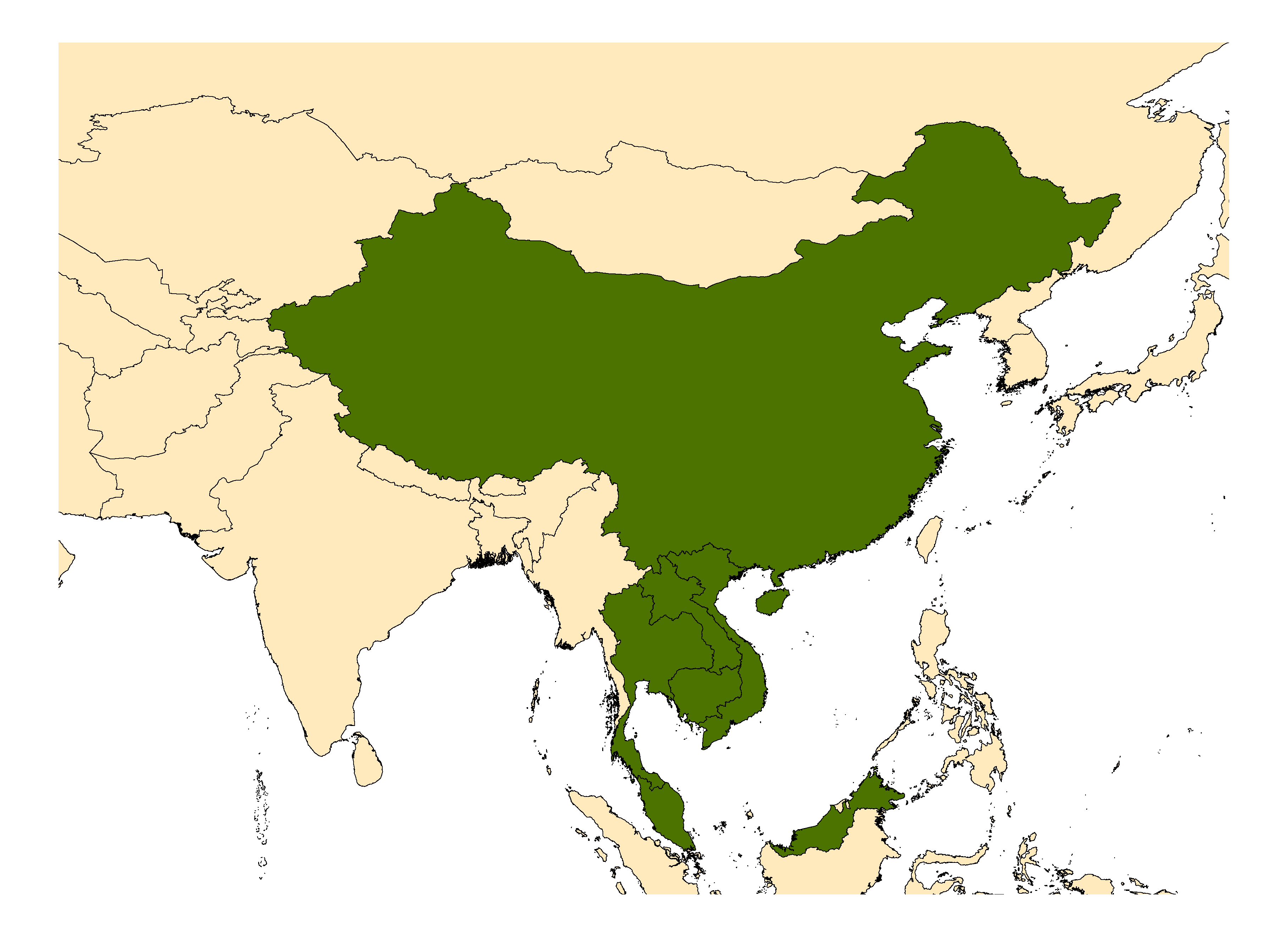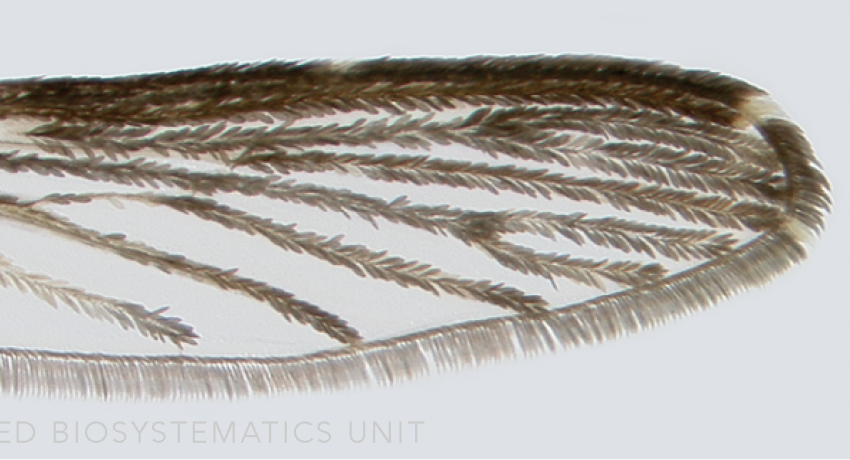ORIENTAL REGION
Etymology: of fields (L); from broad aluvial plains
Anopheles campestris is one of six formally recognized species in the Barbirostris Complex. Other species include An. barbirostris van der Wulp, An. dissidens Taai & Harbach, An. saeungae Taai & Harbach, An. vanderwulpi Townson & Harbach, and An. wejchoochotei Taai & Harbach (formerly ”campestris-like”). The latter taxon was first separated from An. campestris s.s. based on cross-mating studies and mitotic karyotypes. The mitotic karyotype of An. campestris reveals a telecentric Y-chromosome, unique amongst other members of the Barbirostris Complex. Three karyotypic forms have been noted in An. wejchoochotei.
Prior to the discovery of An. wejchoochotei the distribution of An. campestris included mainland Southeast Asia (Cambodia, Malaysia, Thailand, Vietnam), doubtful records from China, and its invasive establishment on Guam. Since then, An. campestris has been molecularly confirmed in peninsular Malaysia and in Thailand. Anopheles wejchoochotei is widely distributed in Thailand and likely to occur elsewhere. Further studies are needed to fully elucidate their distributions.
Type locality: Rantau Panjang, Klang, Selangor, Malaya [Malaysia]
Type depository: Natural History Museum, London, England (NHMUK)
DIAGNOSTIC CHARACTERS (Click photos to view; mouse over and click large photo to zoom in.)
ADULT (illustrated): Head: Clypeus without patch of scales; palpus shaggy in appearance. Abdomen: Sterna with many white scales scattered between median patch and lateral rows; VII-S with tuft of black scales. Legs: Fe-III without distal broad preapical white bands. Thorax: Antepronotal scales (ApSc) present. Wing: With 3 dark marks (1,2,3) on costa (C) and veins R-R1; costa without presector pale spot (PSP); apex with 2 small pale spots (i, ii), without pale spot at end of vein R2.
LARVA (not illustrated): Head: Seta 1-A with very long branches; seta 3-C multi-branched. Thorax: Seta 1-P with ≥4 branches. Abdominal segments: Seta 1 palmate on segments I–VII, well-developed on segments II–VII.
TAXONOMIC KEYS
Nguyen Thuong Hien 1968
Rattanarithikul & Harrison 1973
Rattanarithikul et al. 2006b
![]()
WRBU - Anopheles – Myzorhynchus – Indomalayan - Adult
![]()
WRBU - Anopheles – Myzorhynchus – Indomalayan - Larvae
![]()
WRBU - Anopheles – Myzorhynchus – Oriental Region – Adult
![]()
WRBU - Anopheles – Myzorhynchus – Oriental Region – Larvae
![]()
WRBU - Genera - Global - Adult
![]()
WRBU - Genera - Global - Larva
![]()
WRBU - Anopheles Subgenera and Series - Indomalaya - Adult
![]()
WRBU - Anopheles Subgenera and Series - Indomalaya - Larva
![]()
WRBU - Anopheles Subgenera and Series - Oriental - Adult
![]()
WRBU - Anopheles Subgenera and Series - Oriental - Larva
Exemplar DNA sequences
An. campestris ITS2: HQ424573; COI: AB331582-588
An. wejchoochoteiITS2: AB971306-311, EU812808-809; COI: AB971335-40
BIONOMICS
Immatures
Typical An. campestris immature habitats include shaded ponds, swamps, pools, rice fields, marshes, drainage ditches, canals, wells, and deep animal footprints in pasture lands. These ground-water habitats are typically still or very slow-moving, always with at least some floating, emergent or submerged vegetation. Immature An. wejchoochotei have been collected in rice fields at elevations of 310m in Chiang Mai, Thailand.
Adults
Anopheles campestris are found in low-lying open habitats, and broad alluvial plains, typically at elevations of lower than 200m. Anopheles campestris females are reportedly the most anthrophophilic species of the Barbirostris Complex, and readily enter homes to feed on man. They are regarded as primary malaria vectors, especially in coastal areas of Malaysia. Little is known about the biting habits of An. wejchoochotei, but the mother of the type series was collected at human bait, indicating that the species does bite man.
DISTRIBUTION NOTES
(represents both An. campestris and An. wejchochootei)

WRBU VECTOR HAZARD REPORTS
None; View other WRBU Vector Hazard Reports
Available GIS Models:
IMPORTANT REFERENCES (full citations below)
Reid 1962: 15 (M*, F*, P, L, E)
Nguyen Thuong Hien 1968 (F*, L*; keys, taxonomy, bionomics; Vietnam)
Harrison & Klein 1975 (distribution)
Harrison & Scanlon 1975: 89 (M*, F*, P*, L*)
Rattanarithikul & Harrison 1973 (L; key, Thailand)
Rattanarithikul et al. 2006b (F*, L*; bionomics, distribution, keys)
Taai & Harbach 2015: 258 (M, F, P, L; bionomics, genetics)
CURRENT SYNONYMS
None
CITED REFERENCES
Harrison, B.A., & Klein, J.M. (1975). A revised list of the Anopheles of Cambodia. Mosquito Systematics, 7(1), 11–12.
Harrison, B.A., & Scanlon, J.E. (1975). Medical entomology studies-II. The subgenus Anopheles in Thailand (Diptera: Culicidae). Contributions of the American Entomological Institute, 12(1), iv + 1–307.
Nguyen Thuong Hien 1968. The genus of Anopheles in Vietnam. Saigon: Bureau of Entomology, National Malaria Program/ Republic of Vietnam. English translation by Military Entomology Information Service. 205pp.
Rattanarithikul, R., & Harrison, B.A. (1973). An illustrated key to the Anopheles larvae of Thailand. U.S. Army Medical Component, SEATO, Bangkok, Thailand.
Rattanarithikul, R., Harrison, B.A., Harbach, R.E., Panthusiri, P., & Coleman, R.E. (2006b). Illustrated keys to the mosquitoes of Thailand. IV. Anopheles. Southeast Asian Journal of Tropical Medicine and Public Health, 128(Supplement 2), 2.
Reid, J.A. (1962). The Anopheles barbirostris group (Diptera, Culicidae). Bulletin of Entomological Research, 53, 1–57.
Taai, K., & Harbach, R.E. (2015). Systematics of the Anopheles barbirostris species complex (Diptera: Culicidae: Anophelinae) in Thailand. Zoological Journal of the Linnean Society, 174(2), 244–264.
CITE THIS PAGE
Walter Reed Biosystematics Unit (Year). Anopheles campestris species page. Walter Reed Biosystematics Unit Website, http://wrbu.si.edu/vectorspecies/mosquitoes/campestris, accessed on [date (e.g. 03 February 2020) when you last viewed the site].










































































































































































